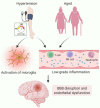Cerebral small vessel disease: Pathological mechanisms and potential therapeutic targets
- PMID: 36034144
- PMCID: PMC9412755
- DOI: 10.3389/fnagi.2022.961661
Cerebral small vessel disease: Pathological mechanisms and potential therapeutic targets
Abstract
Cerebral small vessel disease (CSVD) represents a diverse cluster of cerebrovascular diseases primarily affecting small arteries, capillaries, arterioles and venules. The diagnosis of CSVD relies on the identification of small subcortical infarcts, lacunes, white matter hyperintensities, perivascular spaces, and microbleeds using neuroimaging. CSVD is observed in 25% of strokes worldwide and is the most common pathology of cognitive decline and dementia in the elderly. Still, due to the poor understanding of pathophysiology in CSVD, there is not an effective preventative or therapeutic approach for CSVD. The most widely accepted approach to CSVD treatment is to mitigate vascular risk factors and adopt a healthier lifestyle. Thus, a deeper understanding of pathogenesis may foster more specific therapies. Here, we review the underlying mechanisms of pathological characteristics in CSVD development, with a focus on endothelial dysfunction, blood-brain barrier impairment and white matter change. We also describe inflammation in CSVD, whose role in contributing to CSVD pathology is gaining interest. Finally, we update the current treatments and preventative measures of CSVD, as well as discuss potential targets and novel strategies for CSVD treatment.
Keywords: blood-brain barrier breakdown; cerebral small vessel disease; cognitive impairment; endothelial dysfunction; inflammation; white matter change.
Copyright © 2022 Gao, Li, Lin, Thomas, Miao, Chen, Li and Chu.
Conflict of interest statement
The authors declare that the research was conducted in the absence of any commercial or financial relationships that could be construed as a potential conflict of interest.
Figures



References
-
- Bailey E. L., Wardlaw J. M., Graham D., Dominiczak A. F., Sudlow C. L., Smith C. (2011). Cerebral small vessel endothelial structural changes predate hypertension in stroke-prone spontaneously hypertensive rats: A blinded, controlled immunohistochemical study of 5- to 21-week-old rats. Neuropathol. Appl. Neurobiol. 37 711–726. 10.1111/j.1365-2990.2011.01170.x - DOI - PubMed
-
- Bath P. M., Scutt P., Blackburn D. J., Ankolekar S., Krishnan K., Ballard C., et al. (2017). Intensive versus guideline blood pressure and lipid lowering in patients with previous stroke: main results from the pilot ‘prevention of decline in cognition after stroke trial’ (PODCAST) Randomised controlled trial. PLoS One 12:e0164608. 10.1371/journal.pone.0164608 - DOI - PMC - PubMed
-
- Blair G. W., Appleton J. P., Flaherty K., Doubal F., Sprigg N., Dooley R., et al. (2019). Tolerability, safety and intermediary pharmacological effects of cilostazol and isosorbide mononitrate, alone and combined, in patients with lacunar ischaemic stroke: The LACunar Intervention-1 (LACI-1) trial, a randomised clinical trial. EClinicalMedicine 11 34–43. 10.1016/j.eclinm.2019.04.001 - DOI - PMC - PubMed
Publication types
LinkOut - more resources
Full Text Sources

